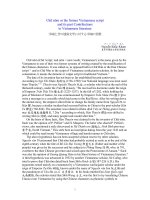Travel to Italy - Milan ppt
Bạn đang xem bản rút gọn của tài liệu. Xem và tải ngay bản đầy đủ của tài liệu tại đây (13.21 MB, 204 trang )
Download free ebooks at bookboon.com
2
Download free ebooks at bookboon.com
3
Italy
© 2010 Stig Albeck & Ventus Publishing ApS
All rights and copyright relating to the content of this
book are the property of Ventus Publishing ApS, and/or its
suppliers. Content from ths book, may not be reproduced
in any shape or form without prior written permission from
Ventus Publishing ApS.
Quoting this book is allowed when clear references are made,
in relation to reviews are allowed.
ISBN 978-87-7061-443-6
2
nd
edition
Pictures and illustrations in this book are reproduced according
to agreement with the following copyright owners
Stig Albeck.
The stated prices and opening hours are indicative and may
have be subject to change after this book was published.
Download free ebooks at bookboon.com
Italy
CHAPTER
4
Download free ebooks at bookboon.com
Italy
5
Travelling to Milan
Travelling to Milan
www.Milano-infotourist.com
www.regione.lombardia.it
www.enit.it
Milan is the dynamo of Italy, and it combines the
Central European atmosphere with the mood of the
Mediterranean.
Milan’s history is a testimony to its central location
on the Po plain’s crossroads of the world. Roman
ruins and old fortresses from its period as capital of
Lombardy are some of the city’s most fascinating
attractions.
Milan’s famous cathedral is the city’s icon and
definitely one of the attractions any visitor ought to
see, but there are also other churches, art museums
and the modern San Siro arena, one of Europe’s true
soccer cauldrons.
In the area surrounding Milan there are both
interesting cultural cities and beautiful nature. Milan
is not far from the Alps nor from the Mediterranean,
and the lakes Lago di Como and Lago Maggiore,
both surrounded by small, charming villages, are
even closer.
Have a nice trip!
Download free ebooks at bookboon.com
Italy
6
Historical outline
Historical outline
The Milan region has been inhabited for thousands
of years, but it was only when the Celts settled the
area around the River Po in 600 BC that a lasting
development began.
The Romans defeated the Celts in 222 BC, and the
city quickly gained significance in the Roman Empire
as a link between Rome and north-western Europe.
Milan became more and more integrated in the
Roman Empire, and after centuries of positive
development it became capital of the region in the
year 286. Milan kept growing after this and soon
became Western Europe’s most important city
second only to Rome. In 313, Constantine made
Christianity the official religion, and Milan’s religious
and cultural influence grew considerably. The
Church also gained greater political power during
this time.
The fall of the West Roman Empire in 476, meant
that Milan was no longer a capital. The city was
frequently attacked from the north, notably by the
Goths. Milan allied itself with the enemies of the
Goths in Byzantium, but lost. The Goths killed most
of the city’s population in 539 and Milan had to start
its development all over.
Byzantium won back the city and surrounding area
from the Goths in 568, but soon after the Langobards
and the city of Pavia took over Milan. In this period
there was no significant rebuilding of the city.
In 774, the Franks conquered the city and the
Church once more ruled the city, which soon
blossomed. Trade increased and a growing merchant
class appeared, which created the foundation for
Milan’s further development. Milan became a city
state in 1042, and it once again became the centre of
the region.
The external foe was now the German-Roman
Empire and its Emperor Barbarossa. In 1162,
Barbarossa conquered Milan, and the city was
completely destroyed for the second time. After the
defeat, the Lombard League was formed with Milan
at the head.
Subsequently Barbarossa was defeated by the
Lombard League and the league members regained
their independence.
For a period of several hundred years from the mid-
13th century onwards, Milan was ruled by wealthy
families: Torriani, Visconti and Sfroza. The families
erected large monuments and buildings, and they
invited leading artists and architects to the city.
Milan and its cultural life became leading in Italy,
along with Florence, and the city’s sphere of
influence increased to include most of northern
Italy.
The families in power were actively supporting art,
culture and development, especially under Lodovica
Sfroza at the end of the 15
th
century. These priorities
attracted artists like Leonardo da Vinci to Milan.
The following years, Italy and Milan fell into a
recession. The other Powers in Europe had grown
stronger and Milan came under frequent attack. In
1535, Milan became a province in the Spanish
Empire of Karl V
Spain built fortifications around Milan and the
population increased, but the economy was still
stagnating, and when the city was hit by the plague
in 1630, the economy plunged and the population
was halved.
Download free ebooks at bookboon.com
Please click the advert
Italy
7
Historical outline
The War of the Spanish Succession weakened
Spain’s control of Milan, and in 1706 Austria
invaded the city. Milan quickly regained strength
under the Austrians, especially in the cultural area. In
1796, Napoleon conquered the city. Under
Napoleon, Milan became capital of the Cisalpine
Republic, and Napoleon was crowned in its
cathedral. After the fall of Napoleon, Milan again
came under Austrian control until 1859.
At this time, there was an increasing nationalist
sentiment in Italy, and in 1860 Milan joined the
Kingdom of Italy.
Austria had left Milan with a good infrastructure,
and the once more Italian city soon became the
economic centre of the country. The population
increased drastically with the industrialisation, and
the city grew in size.
During the 2nd World War, Milan came into the
historical focus. Mussolini’s movement started there,
the city sustained heavy bombardment because of
its large industry and Mussolini was captured and
executed in Milan in 1945.
Due to the general industrialisation after the war,
Milan quickly started developing again, and the
entire region became one of Europe’s leading
regions, which it still is today.
Download free ebooks at bookboon.com
Italy
8
Trip 1: Milan
Trip 1: Milan
1. The Cathedral/Duomo
Piazza del Duomo
www.duomoMilan.it
Metropolitana: Duomo
Milan’s cathedral, with its five ships, its statues and
its spire, is a unique sight. Its impressive dimensions
are only surpassed by St Peter’s Church in Rome and
the Cathedral of Seville.
The cathedral’s ground plan measures 158x92, the
central ship is 45 metres tall and the tallest spire is
108 metres. The gilded statue of Maria, La
Madonnnina, measures 4.2 metres and the large
church room accommodates 40,000 people.
The church was founded in 1386 on an initiative
from Duke Gian Galeazzo Visconti, but it took
almost 500 years before the building was completed
in 1858. The style is Gothic, but the impressive
facade, designed around the year 1800, contains
other elements, mainly Baroque.
There is much to see both inside and outside.
Thousands of statues adorn the cathedral and it is
possible to get up on the roof and view the many
towers and spires from there.
Inside the church, the more than 20 metres high
stained-glass window in the apse is very impressive,
as is the crucifix above the altar. There are also
various cenotaphs for arch bishops, some beautiful
altars by Pellegrino Pellegrini and Marco d’Agrates
and a sculpture by St Bartholomew.
2. The Cathedral Museum/
Museo del Duomo
Piazza del Duomo
www.duomoMilan.it
Metropolitana: Duomo
The Cathedral Museum details the 500-year history
of the cathedral’s construction, as well as some of
the everyday life and activities around it. There are
also various works of art, which are not on display
in the church itself for one reason or another. The
museum was founded in 1953, but the concept was
formed in the 19th century.
3. The Royal Palace/Palazzo Reale
Download free ebooks at bookboon.com
Italy
9
Trip 1: Milan
Piazza del Duomo
www.comune.Milan.it/palazzoreale
Metropolitana: Duomo
Palazzo Reale was, as the name suggests, the
residence of Milan’s rulers, who count among them
Austrian arch dukes.
The original building was from the 11th century, but
after an almost complete rebuilding, the palace as it
stands today was opened in 1778. Today, the palace
hosts various exhibitions.
4. Galleria Vittorio Emanuele II
Piazza del Duomo
Metropolitana: Duomo
Galleria Vittorio Emanuele II is Milan’s most
distinguished shopping arcade. It was designed in
1861, built in 1865-1877 and named in honour of
the united Italy’s first king.
The building is in typical 19
th
century arcade style,
with monumental entrances and glass roof covered
by a large glass dome.
If a visitor turns two times on his heel on the image
of the bull in the floor mosaic in the arcade square, it
will bring good luck and guarantee his return to
Milan.
5. Scala Square/Piazza della Scala
Piazza della Scala
Metropolitana: Duomo
Scala Square is one of Milan’s central squares, and it
is surrounded by interesting buildings. One of the
arcades in Galleria Vittorio, Emanuele II, opens
into the square. The 16th century palace, Palazzo
Marino, is also located there. It was built for the
Marino Family in 1557-1563, and it is the home of
Milan’s local government.
At the centre of the square, there is a statue of
Leonardo da Vinci from 1872. Da Vinci was
working in the city from 1482 to 1499.
5a. The Scala Theatre/Teatro alla Scala
Download free ebooks at bookboon.com
Italy
10
Trip 1: Milan
www.teatroallascala.org
Teatro alla Scala, or just ”La Scala”, is one of the
most famous opera houses in the world. It opened in
1778 with a performance of Antonio Salieris opera
in two acts; Europa riconosciuta. There is room for
about 2,000 spectators in the beautiful theatre, which
is adorned with gilded wood and red velvet.
La Scala replaced the Teatro Ducale, which burned
down in 1776, and its name is derived from the
church Santa Maria, or della Scala, which previously
stood there. The design was approved by Empress
Maria Theresia.
Scala’s theatre museum, Museo Teatrale alla Scala, is
visible from the hall. The museum exhibits various
historical effects, such as costumes and paintings.
6. Church of San Fedele/
Chiesa di San Fedele
Piazza San Fedele
www.sanfedele.net
Metropolitana: Duomo
The Curch of San Fedele is a Jesuit church, built in
the 1550s. It is an interesting example of the building
style of the opponents of the Reformation, and it
also holds various works of art.
7. The Poldi Pezzoli Museum/
Museo Poldi Pezzoli
Via Alessandro Manzoni 12
www.museopoldipezzoli.it
Metropolitana: Montenapoleone
The Poldi Pezzoli Museum has one of Milan’s
finest collections of art and various historical
articles. The collection was established in the 19
th
century by the noble Poldi Pezzoli, and the exhibits
date as a far back as the time of Ancient Rome.
Numerous Italian artists, as well as other European
painters are represented among the exhibited works
of art.
The museum building used to be Poldi Pezzoli’s
home, and it gives a good impression of the way of
life of the Milanese aristocracy 200 years ago.
Download free ebooks at bookboon.com
Please click the advert
Italy
11
Trip 1: Milan
8. The Brera Pinachotek/
Pinacoteca di Brera
Via Brera 28
www.brera.beniculturali.it
Metropolitana: Montenapoleone
This museum has one of Italy’s finest art collections,
with masterpieces by artists such as Raphael. All the
main schools of art between the 13th and 20th
centuries are represented.
The museum is situated in the Baroque palace,
Palazzo Brera, which was a Jesuit monastery from
1572. In 1773, the monastery was dissolved, and in
1776 the Brera Academy of Art, Accademia di Belle
Arti di Brera, was established, and the acquisition of
artworks, notably from closed North Italian
monasteries, began at a rapid pace.
© Deloitte & Touche LLP and affiliated entities.
360°
thinking
.
Discover the truth at www.deloitte.ca/careers
© Deloitte & Touche LLP and affiliated entities.
360°
thinking
.
Discover the truth at www.deloitte.ca/careers
© Deloitte & Touche LLP and affiliated entities.
360°
thinking
.
Discover the truth at www.deloitte.ca/careers
© Deloitte & Touche LLP and affiliated entities.
360°
thinking
.
Discover the truth at www.deloitte.ca/careers
Download free ebooks at bookboon.com
Italy
12
Trip 1: Milan
Download free ebooks at bookboon.com
Italy
13
Trip 2: Milan
Trip 2: Milan
9. Sforza Castle/Castello Sforzesco
Piazza Castello
www.Milancastello.it
Metropolitana: Cairoli/Cadorna/Lanza
Castello Sforzesco is a “real” castle with a moat,
walls and towers in an impressive complex, which,
along with the cathedral, is Milan’s icon.
The original castle was built by the Vicente Family as a
fortress in the 1360s, but, as the name suggests, it was
the later Sforza Family that moved in there. In 1450,
Francesco Sforza rebuilt and extended the complex,
and later generations also made various changes.
The entrance to the castle is via the Filarete tower,
Torre del Filarete, from 1521, which was rebuilt in
honour of King Umberto in 1900-1905. Behind the
tower, it is possible to go for a walk around the
grounds or visit the various parts where some of
the city’s museums are located. Visitors also have
access to halls decorated with tapestries and frescos
from the 15
th
century. The art museum, Pinacoteca
del Castello Sforzesco, hplds some of the greatest
attractions, such as Michelangelo’s last sculpture
and several of Leonardo da Vinci’s manuscripts.
In the square in front of the castle, Piazza Castello,
a number of 19
th
century buildings in Monumental
style are arranged in a semi-circle.
10. Parco Sempione
Viale Molière/Viale Gerolamo Gadio
www.triennale.it
www.acquariocivico.mi.it
Metropolitana: Cadorna/Lanza
The beautiful park, Parco Sempione, lies next to
Castello Sforzesco, and there is a beautiful view of
the castle. It was laid out in 1893 in English
landscape style with a lake at the centre.
One of the buildings in the park is the Palace of Art,
Palazzo dell’Arte, built in 1933 to accommodate
Milan’s Triennale, which hosts exhibitions of Modern
art, industrial art and handicraft. Milan’s aquarium,
Acquario Civico, is also found in the park
Download free ebooks at bookboon.com
Please click the advert
Italy
14
Trip 2: Milan
11. Arena Civica
Viale Giorgio Byron 2
Metropolitana: Lanza/Moscova
The stadium, Arena Civica, is inspired by the
Ancient Roman arenas. It was built in a neo-Classical
style and opened in 1807. It is situated close by
Castello Sforzesco, so the castle could form the
backdrop of public celebrations as opposed to war.
12. Arc of the Peace/Arco della Pace
Piazza Sempione
Metropolitana: Cadorna/Moscova
At the end of Parco Sempione, stands the Arco della
Pace. It was inaugurated in 1838 in memory of the
European peace agreement at the Congress of
Vienna in 1815, signalling the end of the Napoleonic
Wars. The arc was originally meant as a monument
over Napoleon’s victories.
13. Corso Sempione
Corso Sempione
Metropolitana: Cadorna/Moscova
Corso Sempione begins at the Arc of the Peace and
Sforza Castle. It was built during the time of
Napoleon as a Milanese counterpart to Champs
Elysées, with a triumphal arc as its icon. The shady
boulevard is a nice place for a walk.
14. Cimitero Monumentale
Increase your impact with MSM Executive Education
For more information, visit www.msm.nl or contact us at +31 43 38 70 808
or via
the globally networked management school
For more information, visit www.msm.nl or contact us at +31 43 38 70 808 or via
For almost 60 years Maastricht School of Management has been enhancing the management capacity
of professionals and organizations around the world through state-of-the-art management education.
Our broad range of Open Enrollment Executive Programs offers you a unique interactive, stimulating and
multicultural learning experience.
Be prepared for tomorrow’s management challenges and apply today.
Executive Education-170x115-B2.indd 1 18-08-11 15:13
Download free ebooks at bookboon.com
Italy
15
Trip 2: Milan
Piazzale Cimitero Monumentale
www.monumentale.net
Metropolitana: Garibaldi FS
As the name suggests, Cimitero Monumentale is a
monumental churchyard. It opened in 1866, and in
addition to the impressive entrance there are Greek
temples, classical sculptures, obelisks and various
other works of art, such as a scale model of Trajan’s
Column, Colonna di Traiano, from Rome.
The entrance is the Temple of Fame, Famedio, which
is a colossal building of marble and stone, serving as a
grave for some of Italy’s most revered figures.
Many famous people have been buried in this
churchyard. Notably, Eva Perón lay buried there
between 1955-1971 under the name María Maggi.
Download free ebooks at bookboon.com
Italy
16
Trip 3: Milan
Trip 3: Milan
15. The St Ambrogio Basilica/Basilica
Sant’Ambrogio
Piazza Sant’Ambrogio
Metropolitana: Sant’Ambrogio
This basilica is one of Milan’s oldest churches. It was
originally built by a bishop in the years 379-386 and
called Basilica Matyrum because many martyrs had
been buried there.
It has since been extended several times, and the
present Roman-style buildings were finished in 1099.
The architecture is typical Lombardian-Roman, and
the result is very impressive. The smallest of the two
towers is from the 9
th
century, while the tallest was
built in 1144 and extended in 1889.
The pleasant yard with a view to the two towers, the
large church room, the mosaic and a sarcophagus from
the 5
th
century are a few of the many historical
attraction at St Ambrogio. In addition there is the grave
of Emperor Ludovico II from 875 inside the church.
16. Università Cattolica
Largo A. Gemelli 1
www.unicatt.it
Metropolitana: Sant-Ambrogio
Behind the St Ambrogio Basilica stands the
church’s monastery complex from the 15th century.
In 1921, Milan’s Catholic university moved into the
beautiful facilities, with the delightful inner
courtyards and impressive cloisters.
17. The Circus/Circo
Via Circo
Metropolitana: Sant’Ambrogio
The most important cities in the Roman Empire all
had a circus; an arena where the Emperor could
receive the homage of the people. Milan was one of
two cities in Northern Italy that had a circus. The
impressive facility was almost 500 metres long and
80 metres wide, and it is thought to have been built
by Emperor Maximian in the 4
th
century.
Today, there is not much left of the circus, which
was situated between the current Corso Magenta to
the north Via Circo to the south, Via Cappuccio to
the west and Via Brisa and Via Morigi to the east.
18. Roman Ruins in Via Brisa/
Resti romani di Via Brisa
Via Brisa
Metropolitana: Cardona
Visitors to Via Brisa can see the preserved
remnants of Emperor Maximian’s residential palace,
built in the 4th century when Milan was capital of
the West-Roman Empire. It is thought that the
palace spanned an area between the current Via
Meravigli and Via Torino.
Download free ebooks at bookboon.com
Italy
17
Trip 3: Milan
19. The Archaeological
Museum/Civico Museo Archeologico
Corso Magenta 15
Metropolitana: Cadorna
Milan’s Archaeological Museum has various
interesting exhibitions. The main attraction is the
exhibition about Milan at the time of Ancient Rome,
but the collection of Greek and Etruscan ceramics
and the antique coin collection are also interesting.
20. The Litta Palace/Palazzo Litta
Corso Magenta 24
www.teatrolitta.it
Metropolitana: Cadorna
The Litta Palace was built as residence for Count
Bartolomo Arese in 1642-1648. Since Arese was one
of Milan’s most important families, the Litta Palace
became a place of culture and entertainment.
By the 18
th
century, there were no more male heirs
in the Arese Family and the palace was taken over by
the Litta Family, who rebuilt parts of it. The present
facade was built in 1752-1761.
The palace is exquisitely furnished, and today it
contains part of the Italian State Railways’
administration. The palace also houses Milan’s
oldest theatre, Teatro Litta di Milano.
21. Santa Maria delle Grazie
Piazza Santa Maria delle Grazie 2
www.cenacolovinciano.it
Metropolitana: Cadorna
Santa Maria delle Grazie is a church and monastery
complex, built on an initiative by Duke Francesco I
Sforza. Construction began in 1463 and was
completed in 1469. The church was completed in
1490, and its exterior is quite different from Milan’s
other churches. Inside, there many decorations and
frescos dating back to the 15
th
century, among them
Leonardo da Vinci’s masterpiece, “The Last
Supper”/Il Cenacolo. It was painted in 1495-1498,
while da Vinci lived in Milan, and it measures 8.8 x
4.6 metres. It is on display in the refectory.
Download free ebooks at bookboon.com
Please click the advert
Italy
18
Trip 3: Milan
22. San Siro
Via Piccolomini 5
www.sansiro.net
www.sansirotour.com
www.acmilan.com
www.inter.it
Metropolitana: Lotto Fiera 2
San Siro is the popular name of the Stadio
Giuseppe Meazza. This stadium is homeground for
two of Italy’s most succesful football clubs, A.C.
Milan and F.C. Internazionale (Inter).
The Stadium celebrated its opening in 1926 with a
match in which Inter beat A.C. Milan 6-3. San Siro
has undergone several extensions and today it
accomodates more than 80,000 spectators. With its
steep stands, it is said to have a unique atmosphere
during matches.
The Stadium also has a museum (entrance in gate
14), and guided tours of the impressive facility.
Get “Bookboon’s Free Media Advice”
See the light!
The sooner you realize we are right,
the sooner your life will get better!
A bit over the top? Yes we know!
We are just that sure that we can make your
media activities more effective.
Download free ebooks at bookboon.com
Italy
19
Trip 3: Milan
Download free ebooks at bookboon.com
Italy
20
Trip 4: Milan
Trip 4: Milan
23. Biblioteca & Pinacoteca
Ambrosiana
Piazza Pio XI 2
www.ambrosiana.it
Metropolitana: Duomo
Biblioteca Ambrosiana
Is a historical library in Milan, which also houses the
art collection Pinacotaca Ambrosiana. The library
was founded by Cardinal Federico Borromeo around
the year 1600, and he had his agents buy books and
manuscripts from all over the world. Entire libraries
were bought and new works were constantly added
to the collection.
Construction of the library building was begun in
1603, and the first public reading room, Sala
Fredericiana, was opened in 1609, which made this
library the second public library in Europe.
The art collection was made public in 1618, after 7
years of preparation. The collection has many works
from the 15
th
-20
th
centuries
24. Chiesa di Santa Maria
presso San Satiro
Via Falcone
Metropolitana: Duomo/Missori
This church was built in 1472-1482 in a spot where
a small place for prayer had existed since 879. The
architect, Donato Bramante, was one of the people
involved in building the church, and he created the
sacristy, which is the church’s largest attraction. The
special thing about the sacristy is that there was no
room for the planned extension. Instead, Bramante
painted an illusion, a so-called trompe l’oeil, one of
the first in art history.
Download free ebooks at bookboon.com
Italy
21
Trip 4: Milan
25. The San Lorenzo Maggiore
Basilica/Basilica di San Lorenzo
Maggiore
Corsa di Porta Ticinese
Metropolitana: Missori
The San Lorenzo Maggiore Basilica was founded
around the year 370, and it is one of the earliest
church buildings in the world. Much of the
construction has been preserved in the original
Byzantine stile, with the central cupola surrounded
by four towers, modelled on the Hagia Sofia in
Constantinople.
In front of the basilica, there is a colonnade
consisting of 16 Corinthian columns; the Colonne di
San Lorenzo. The columns are from the 3rd century,
and they were previously part of a bath built by
Emperor Maximian. They are among the few
remnants of Ancient Rome in Milan.
26. The Ticinese Gate/Porta Ticinese
Piazzale XXIV Maggio
www.ticinese-Milan.it
Metropolitana: Missori
The city gate, Porta Ticinese, was built by the
Visconti Family in the 13th century as a part of the
reconstruction of Milan’s city wall after
Barbarossa’s destruction of the city. The gate was
restored once more in the 19th century.
27. The Velasca Tower/Torre Velasca
Piazza Velasca 5
Metropolitana: Missori
Torre Velasca is a peculiar looking, 106 metres tall
high-rise, built in 1956-1958. The building style was
meant to be reminiscent of the architecture of the
area’s old fortresses, such as Castello Sforzesco, and it
is a splendid example of Modern Italian architecture.
Download free ebooks at bookboon.com
Italy
22
Trip 4: Milan
28. The San Nazaro in Brolo
Basilica/Basilica di San Nazaro in Brolo
Piazza San Nazaro
Metropolitana: Crocetta
The San Nazaro in Brolo Basilica is one of Milan’s
oldest church buildings. Construction began in 382
by the main road between Milan and Rome,
dedicated to the apostles Andrew, John and Thomas.
The church has been rebuilt in 1075 and in 1571, but
there are still elements in the church from all three
periods. Next to the church stands the Trivulzio
Mausoleum, Mausoleo Trivulzio, whose
construction began in 1512 in Renaissance style. It is,
as the name suggests, the mausoleum of the
Trivulzo Family.
29. The Great Hospital/
Ospedale Maggiore
Via Festa del Perdono 3
Metropolitana: Crocetta
Milan’s great central hospital was built in 1456 by
Duke Francesco Sforza as a replacement for all of
the city’s existing hospitals. Architectural styles
from the 15
th
18
th
century are represented, and the
atmosphere in the complex, with its many yards, is
fantastic. The hospital was in use until 1932, when a
new Ospedale Maggiore was opened. Today, the
old buildings are part of the University of Milan.
30. The Palace of Justice/
Palazzo di Giustizia
Corso di Porta Vittorio
Metropolitana: San Babila
Milan’s Palace of Justice was finished in 1940 to
serve as a new court house building. The
architectural style is typical of the clean
monumental building style of the Fascist era.
31. The Besana Rotunda/Rotunda
della Besana
Via Enrico Besana 12
Metropolitana: San Babila
This large rotunda is from 1695, and it located on
the grounds of an old churchyard. Today, it houses
various exhibitions and activities.
Download free ebooks at bookboon.com
Please click the advert
Italy
23
Trip 4: Milan
32. The Church of Santa Maria della
Passione/Chiesa di Santa Maria della
Passione
Via Vincenzo Bellini 2
Metropolitana: San Babila
This church is one of Milan’s largest. It was finished
in 1486, but was later rebuilt. Giuseppe Rusnati’s
facade from 1729 and octagonal tower are very
beautiful and well worth a visit.
The monastery buildings next to the church have
been converted into a museum, which has Italian
paintings from the 17
th
century, among other things.
The church itself has various interesting frescos and
portraits of saints.
GO T -THE-ENERGY-TO-LEAD.C OM
We believe that energy suppliers should be renewable, too. We are therefore looking for enthusiastic
new colleagues with plenty of ideas who want to join RWE in changing the world. Visit us online to find
out what we are offering and how we are working together to ensure the energy of the future.
Download free ebooks at bookboon.com
Italy
24
Trip 4: Milan
Download free ebooks at bookboon.com
Italy
25
Trip 5: Milan
Trip 5: Milan
33. The New City Gate/
Archi di Porta Nuova
Piazza Cavour
Metropolitana: Montenapoleone/Turati
The new city gate is part of the city wall that was
built in 1171, subsequent to Barbarossa’s campaign.
The wall was reinforced in the year 1330-1339, and it
has been restored and rebuilt several times since,
which has influenced the look of he gate.
Today, there are arcs traversing one of the busy
streets from the square Piazza Cavour. On each side
of the gate, there are preserved parts of the defence
towers which used to protect the entrance. North of
the city gate, at the Piazza Cavour, there is a statue
of Camillo Benso, Conte di Cavour, who was one of
the most important figures in the Italian Gathering
in the 19
th
century.
Next to the statue stands the high-rise, Centro
Svizzero Milan, which was built in 1949-1951. It was
the tallest office building in the city until 1960.
34. Giardini Pubblici
Corso Venezia/Via Palestra
www.villabelgiojosobonaparte.it
Metropolitana: Turati/Palestro/Porta Venezia
Giardini Pubblici is Milan’s first public park and the
home of various interesting buildings. The lovely
park was laid out in 1782-1786. The Park’s buildings
include museum of Natural History, Museo di Storia
Naturale, and the Palazzo Belgiojoso Bonaparte,
from 1790-1796.
The art museum Museo dell’Ottocento (Via Palestra
16) is located in the palace.
35. The Gate of Venice/Porta Venezia
Piazza Guglielmo Oberdan
Metropolitana: Porta Venezia
Porta Venezia was previously known as Porta
Orientale since it was the East Gate. Today there
are two pavilions with loggias, built in 1827-1828.
36. The Pirelli Tower/Grattacielo Pirelli
Piazza della Repubblica
www.regione.lombardia.it
Metropolitana: Centrale FS
Pirelli’s high-rise from 1956-1960 stands in the spot
where the company’s first tyre factory used to be.
With its 127 metres, it was the first building in
Milan that was taller than the Cathedral. Today, the
slender, elegant house is occupied by the provincial
government









